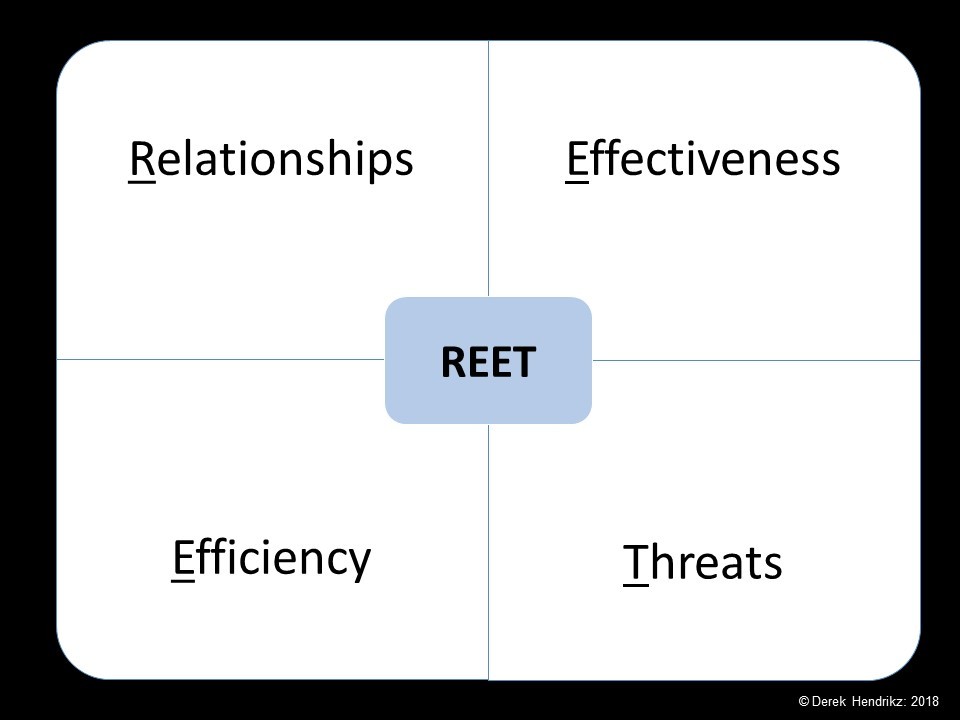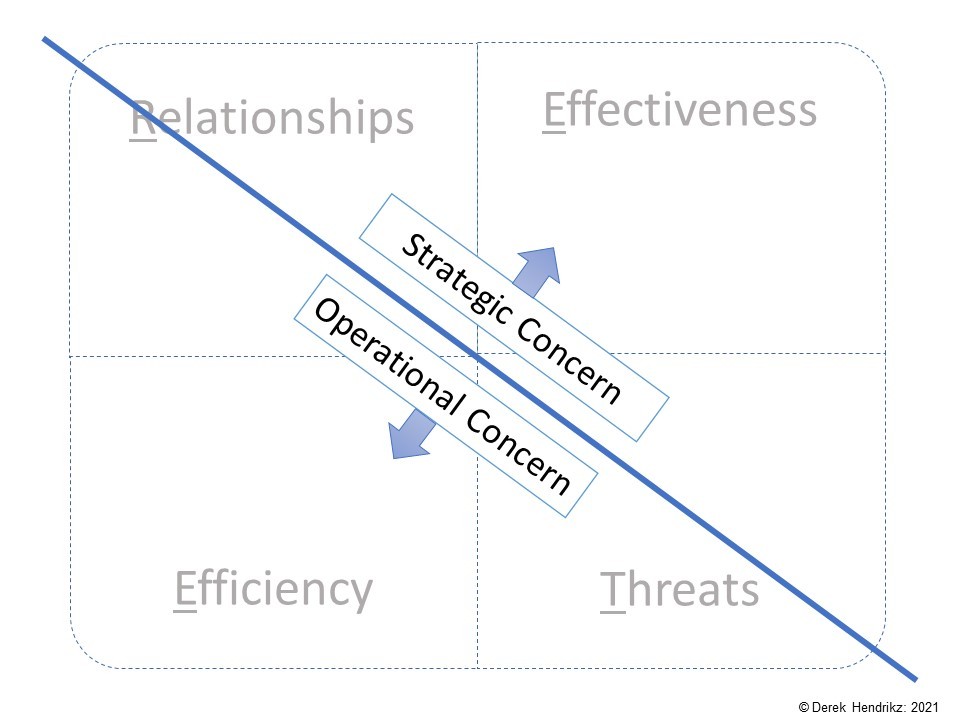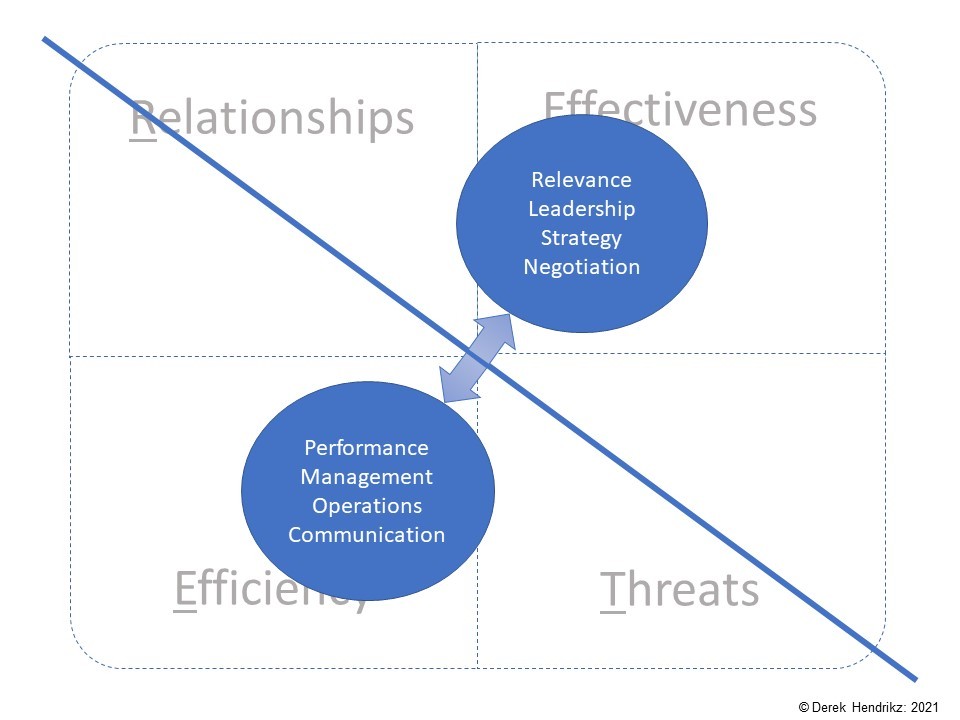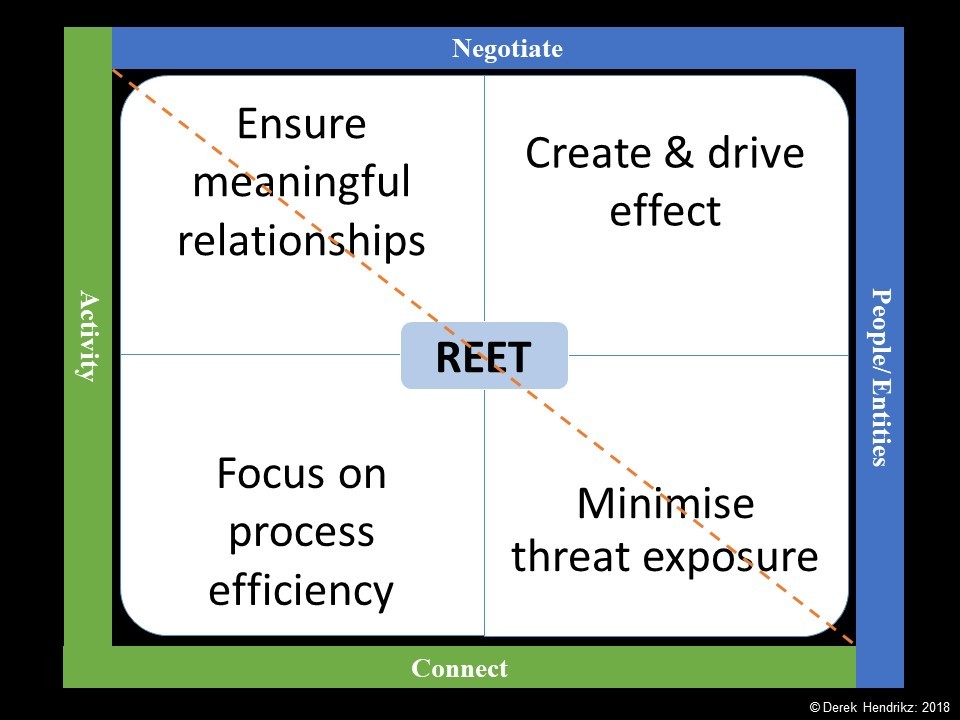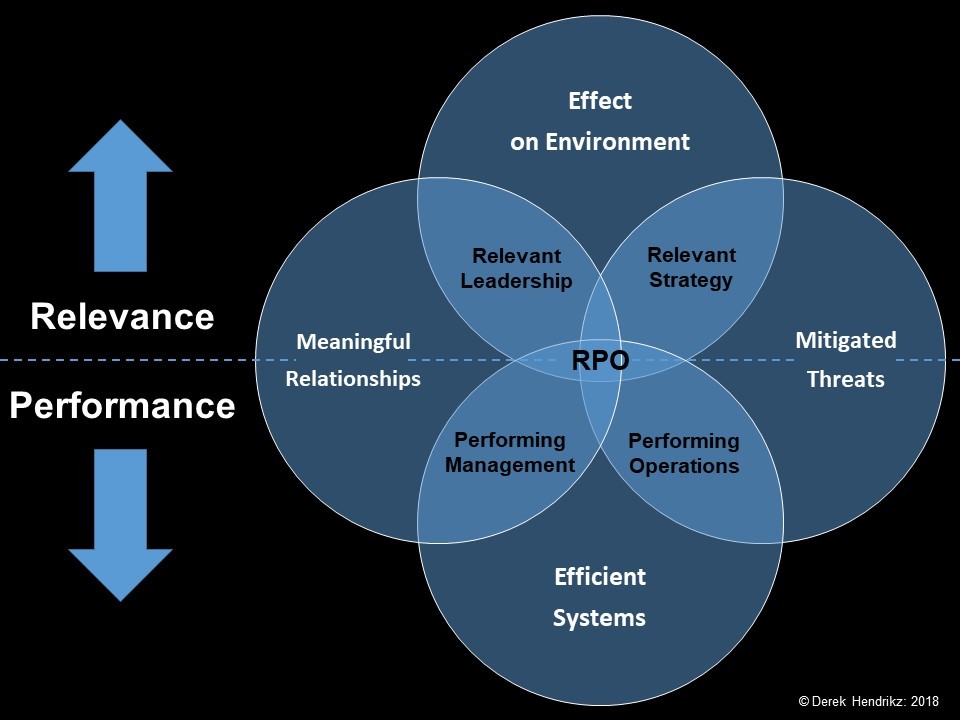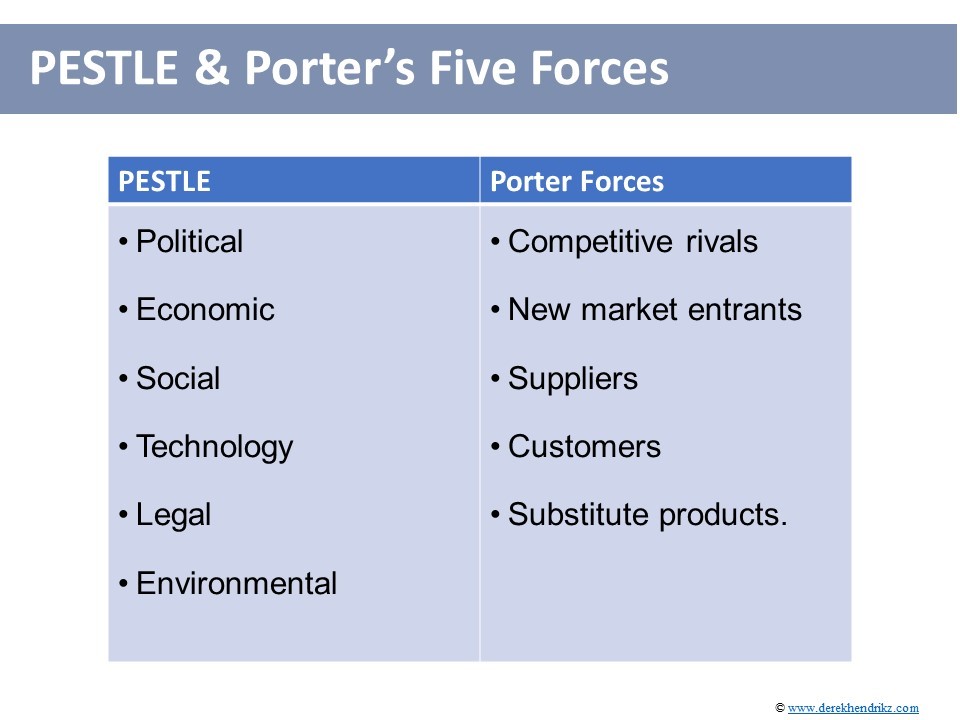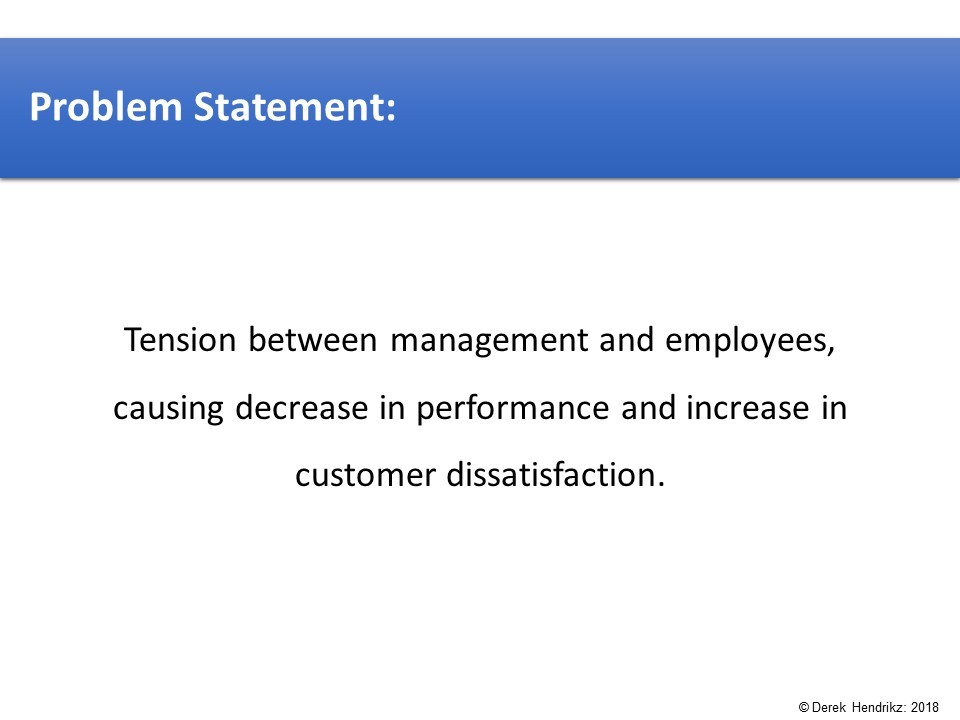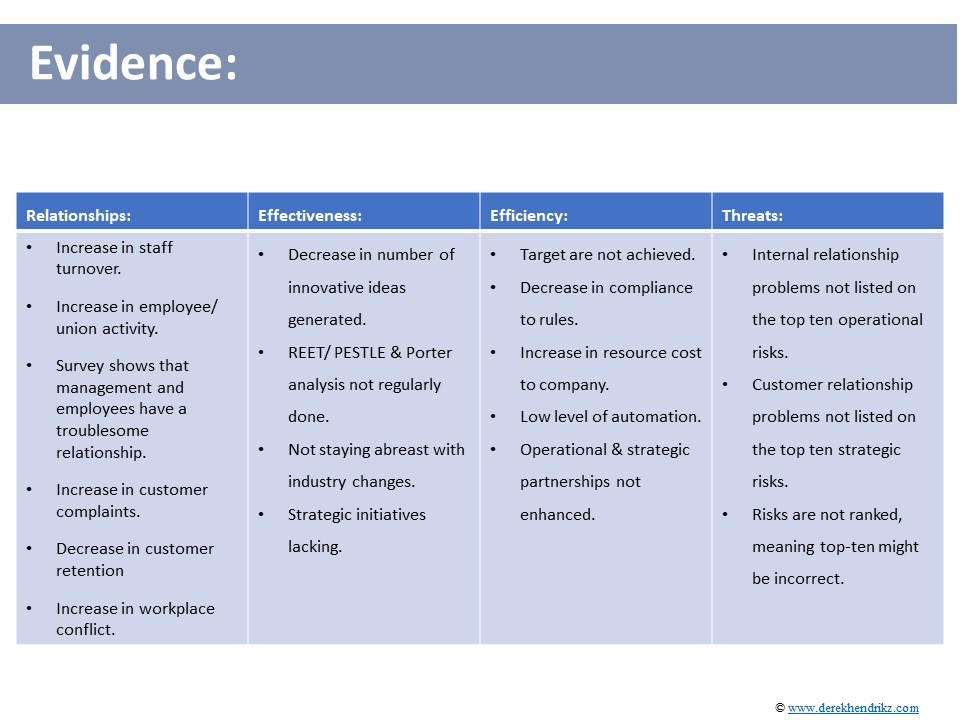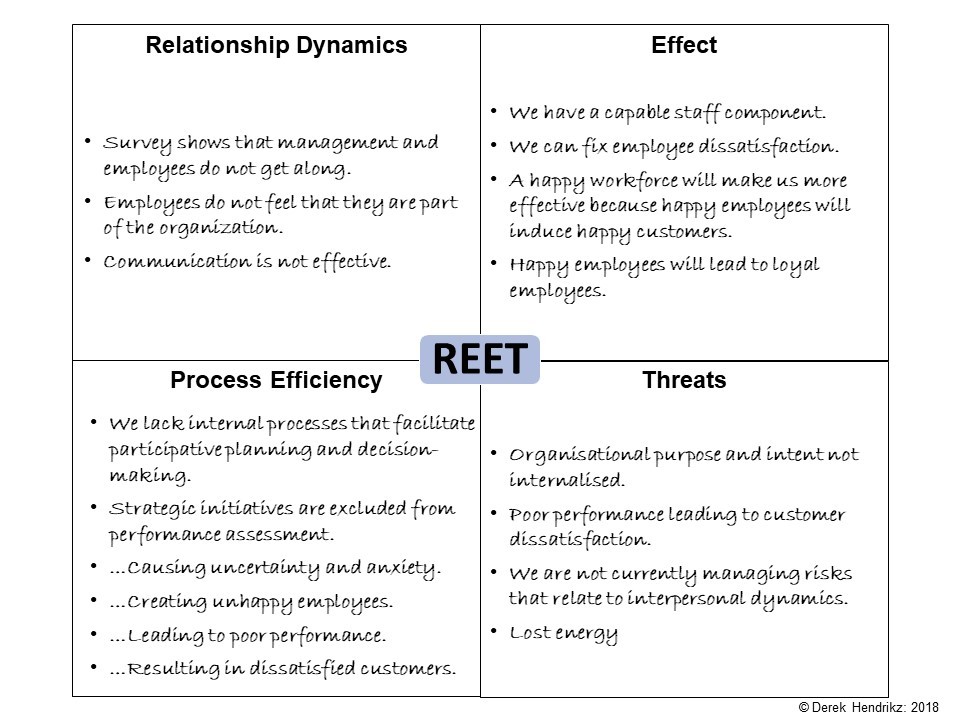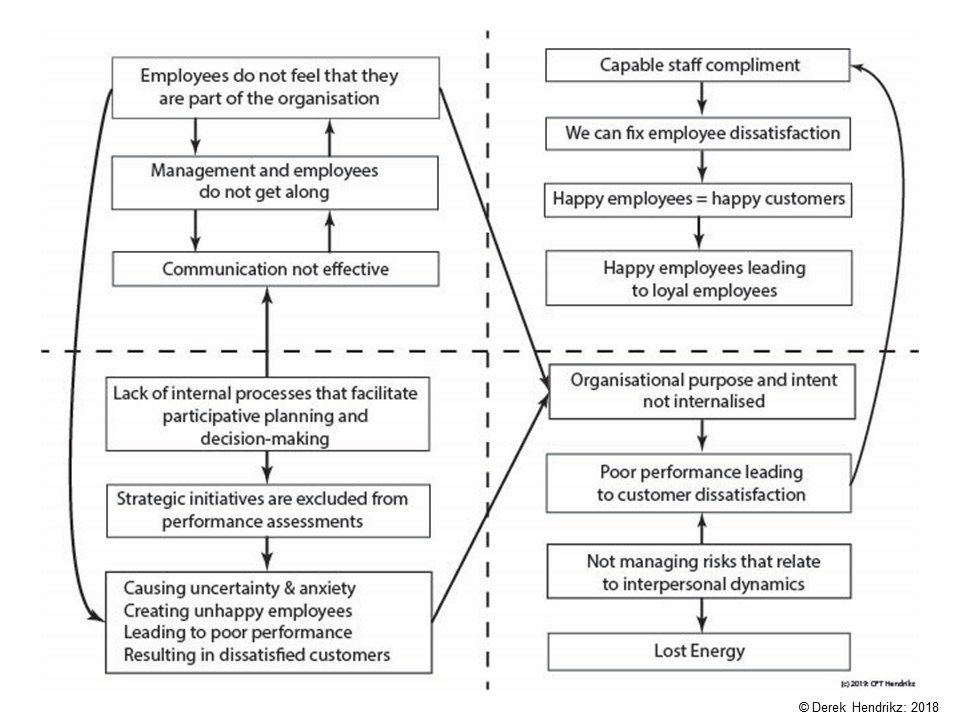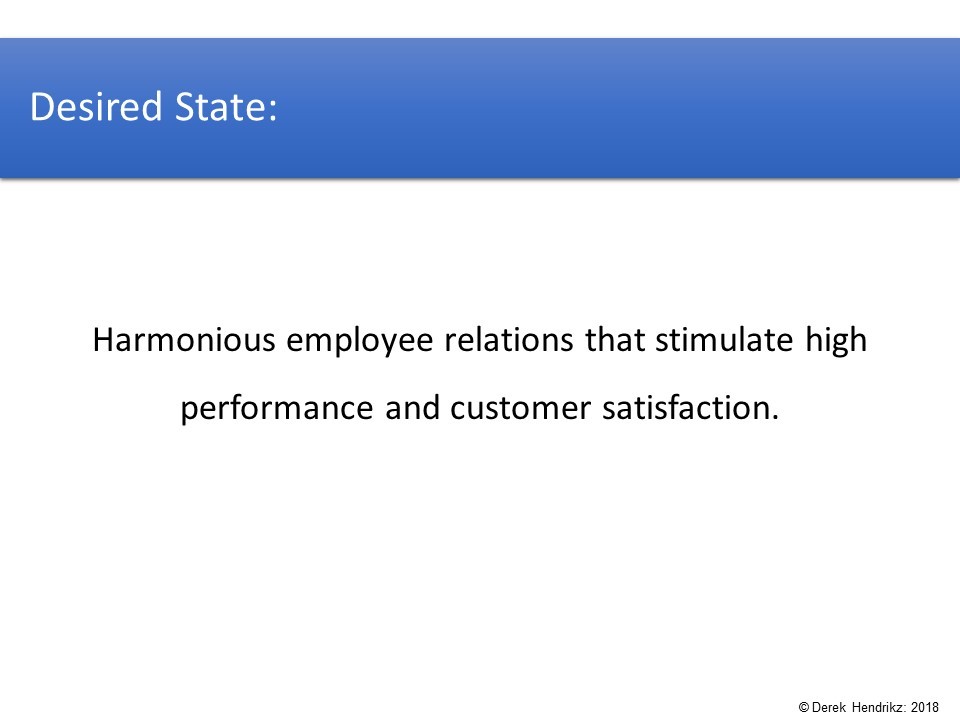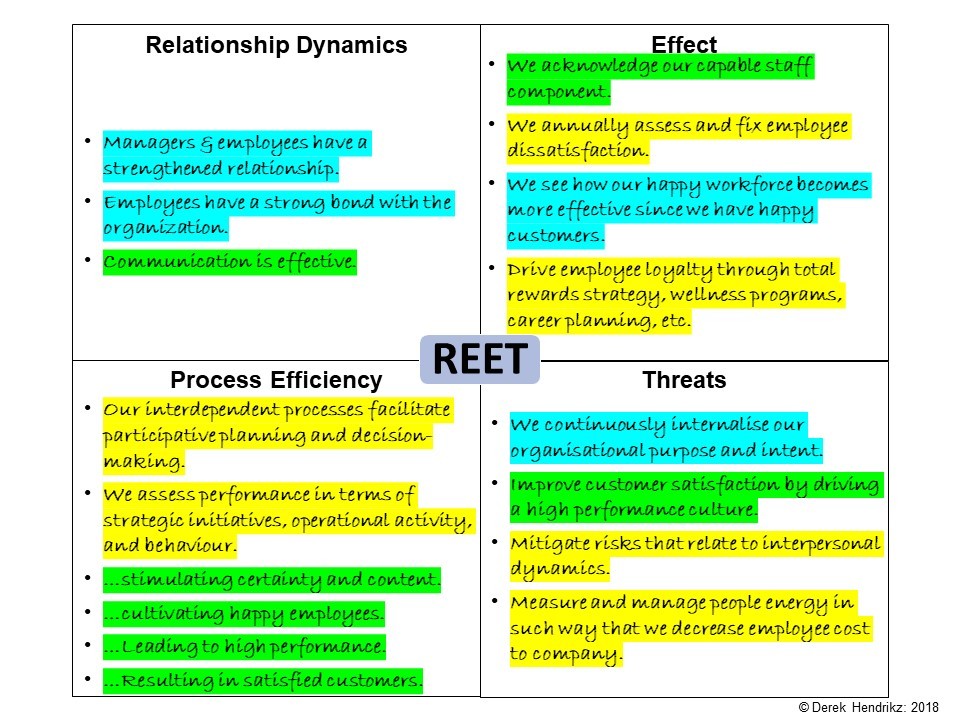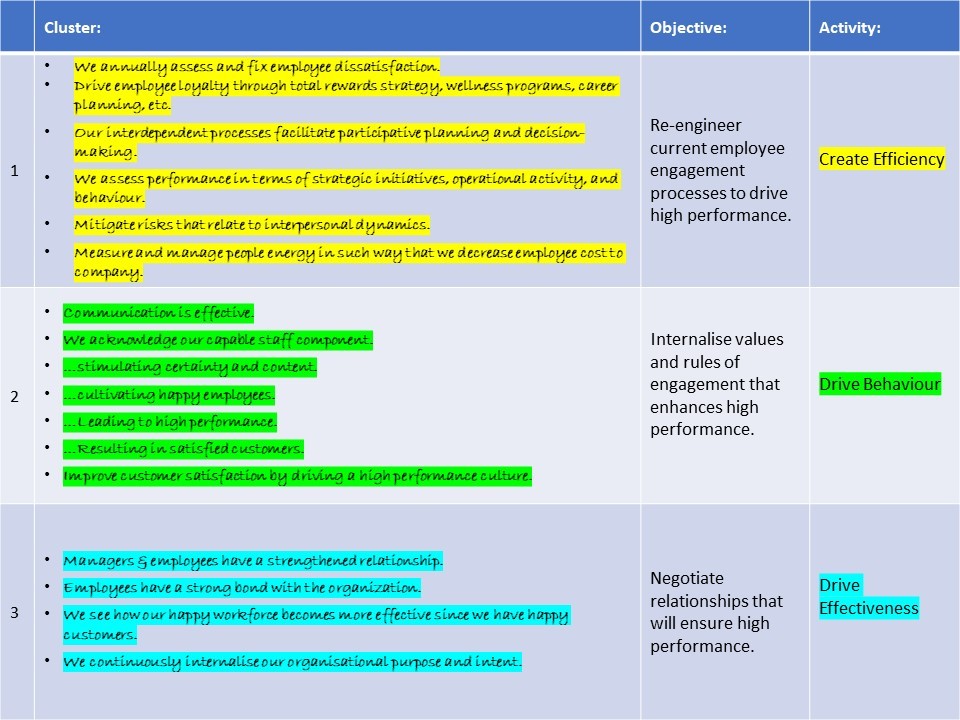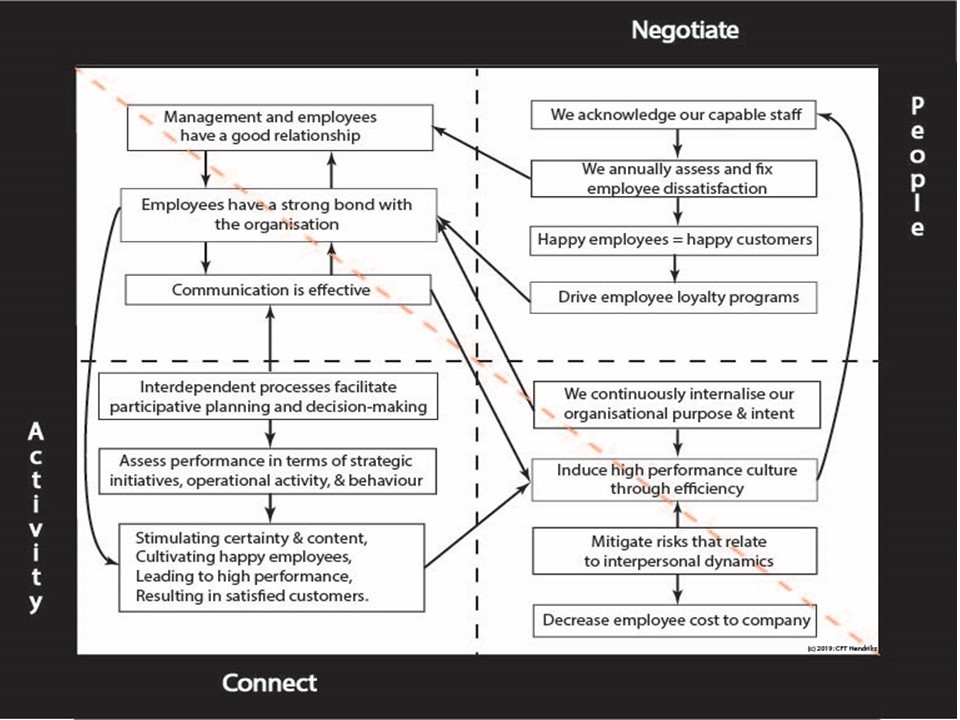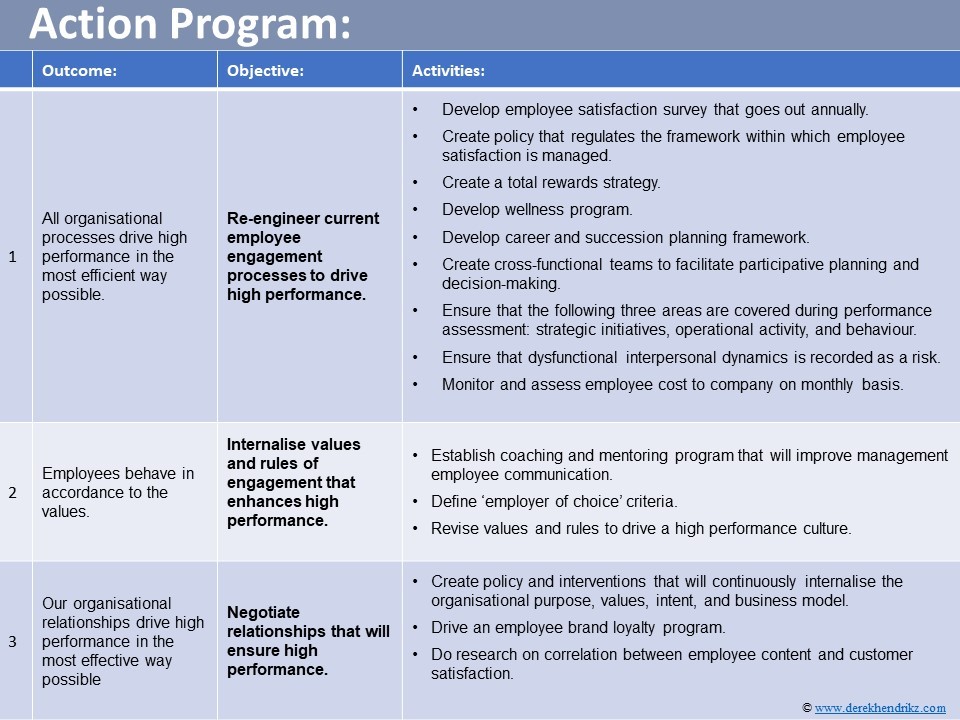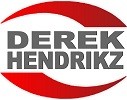The Orgtology Blog
The REET Analysis
Understanding is the foundation of change. Before we can improve, we must understand. REET stands for Relationships, Effectiveness, Efficiency, and Threats. The main purpose of REET is to understand the reality of a team or organisation. From such understanding one can make informed decisions regarding change and maintenance.
I have been using REET over the past decade to get an overview of organisational problems. Its name has changed a few times, but the principles remain. It was first "EOP", then "DOEP", then "ROET", and now "REET". We mostly use it as the first step of a strategy development or organisational design project. In consulting, we begin these projects with a comprehensive REET questionnaire. Yet, REET is as meaningful when used as the basis for a conversation, or for doing a root cause analysis. The "window" model below shows the four dimensions of REET.
Basic Assumption on REET
If REET is an adequate way to analyse the reality of Org, then it should cover both the operational and strategic environments of an organisation. This is because Org must perform and stay relevant, which are respectively issues of operations and strategy.
To perform, Org must be efficient, have meaningful relationships with its employees, and minimise operational threats. To stay relevant, Org must have an effect on its environment, negotiate strong relationships, and ensure that nothing threatens business continuation. Performance is an issue of management, whilst relevance is a matter for leaders. REET thus also gives meaningful guidance in terms of management and leadership.
Org can decide how to spend its resources; thus, its operational and strategic activity share the same resource pool. In so, the relationship between operational and strategic concerns are inverse. This means that the more resources we spend on one, the less we have for the other.
From an orgtology perspective, strategic concerns will reflect projective activity whilst operational concerns reflect receptive activity.
REET vs. SWOT
SWOT is the most known way to grasp the current reality of Org. It stands for Strengths, Weaknesses, Opportunities, and Threats. Strengths and weaknesses are internal, whilst opportunities and threats are external. In so profitable prospects will be an opportunity, whilst our excellent customer service is a strength. Also, lack of automation will be a weakness whilst online delivery of similar services will be a threat.
The greatest concern with SWOT is its internal / external division. As the world continues to connect, the inside / outside split will become hard to grasp. Even in the past there were uncertainties in this regard. E.g., is the governing board internal or external? Payroll seems to be the only real separation. I am not sure of what use such a split would have in terms of analysis. Activity often cross organisational boundaries. In fact, it is mostly the case. E.g., to deliver a parcel will take at least two organisations. From an orgtology perspective, the validity of departments and divisions are rapidly diminishing. The world of work is connecting through cross-functional and cross-organisational teams. To make an internal / external split in this age of AI and integration makes no sense.
SWOT is an oversimplified analysis tool. After one has figured out what is inside and what is out, one is left to one's imagination. Whatever good or bad comes to mind, one jots down. And when one finds a strength, one is not sure what to do with it, because if it can be improved or expanded, then not having done so yet, will make it a weakness.
REET is an orgtology tool, thus its focus is on the receptive / projective movement that maintains Org. By understanding REET, we will know how to transform our operations. This will help us to design effective strategy. Since a central hypothesis (hypothesis 2x) anchors all orgtology theory, we can analyse numerous receptive/projective relationships. These include leadership and management, strategy and operations, efficiency and effectiveness, systems and human intelligence, relevance and performance, etc.
The impact of REET on Leadership & Management
We can respectively grasp the functions of management and leadership through receptive and projective activity. All activity below the inverse REET line is receptive, and all above is projective. The receptive parts of REET relate to management, performance, and operations. The projective parts of REET relate to leadership, relevance, and strategy. Org has full control of its receptive parts; thus, managers will communicate to get things done. Contrariwise, the projective parts of REET must be influenced, thus leaders will have to negotiate to change things.
If a manager's key output is efficiency, then his/her core work will be to connect activity. This is so since one can only achieve efficiency by organising activity. When we map this to the receptive part of the REET window, we can make the following assumptions about connecting activity:
- It will direct our focus on efficiency.
- It will minimise our operational exposure to threats.
- It will ensure meaningful relationships with the people who help run the operations of Org.
If the outcome of leadership is effectiveness, then his/her core work is to negotiate with people and entities. This is because effectiveness is about influencing people and entities that one does not necessarily control. When we map this to the projective part of the REET, we can make the following assumptions about negotiating with people:
- It will help us to exploit opportunities.
- It will enable us to continue business when disaster strikes.
- It will ensure meaningful relationships with our stakeholders.
There are numerous assumptions that we can make when we relate management and leadership to REET:
- Relationships are needed for both performance and relevance, thus it is an issue that must be managed and led.
- Effectiveness is something leaders work with since it is purely an issue of relevance and strategy.
- Efficiency is something managers work with since it is purely an issue of performance and operations.
- Threats affect both performance and relevance, thus it is an issue that must be both managed and led.
Using REET to maintain a Relevant and Performing Organisation
According to Hypothesis 2x, Org must maintain an equilibrium between the energy that it respectively spends on its relevance and its performance. From an orgtology perspective we drive performance through efficiently managing our operations. In so we secure relevance through effectively leading our strategy.
From the attached REET-based Ven diagram one can make the following assumptions:
- Relevance is about leadership and strategy.
- Performance is about management and operations.
- Leaders are relevant when Org has an effect on its environment and meaningful stakeholder relationships.
- Strategy is relevant when Org has an effect on its environment and mitigated business continuation threats.
- Managers perform when there are effective systems and meaningful operational relationships.
- Operations perform when there are effective systems and mitigated operational threats.
- Org will always be relevant if leaders and strategy are effective.
- Systems will always perform if managers and operations are efficient.
- Relationships will always be meaningful if leaders are relevant, and if managers perform.
- Threats will always be mitigated if operations perform, and if strategy is relevant.
These REET-based assumptions guide us to pinpoint and fix problems. E.g., if threats are not mitigated, then we know that either operations are not performing, or strategy is not relevant. We mitigate operational risks though processes (efficiency) and we ensure that business continues through strategy (effectiveness). In so, mitigated risks are a result of performing operations and relevant strategy.
At core to all these relations is the Relevant and Performing Organisation (RPO). To maintain an RPO, one must constantly assess REET data and its analysis. REET is an organisational health check. It ensures that we know what the reality of Org is.
Methods of doing a REET Analysis
The aim of REET is to understand the reality of Org. We do this by understanding how Org relates to other entities, how able it is to stay relevant, how well its processes run, and how conscious it is about the threats it faces. In so, REET analyses relationships, opportunities, efficiency, and threats.
To do a REET analysis can be vastly complex or extremely simple. Like any research, the depth of knowledge that the researcher wants to attain will guide the complexity of the analysis. Following are a few ways to analyse REET. Important to note is that one method does not exclude the other. We can mix and match as we deem fit.
Electronic questionnaires:
Here we will develop a detailed questionnaire around the four dimensions of REET. Short questionnaires mostly require a lot of research on the organisational performance model and its strategy. For this reason, consulting firms mostly circulate long questionnaires. It is efficient for them to create a generic questionnaire that covers everything. I write on the compilation of a REET questionnaire in another essay. It is preferable to send the REET questionnaire to all stakeholders. This brings another complication, in that not all stakeholders will add the same perceptual value. E.g., The governing board would be able to give a much broader perspective on opportunities and threats than frontline staff. This is because they have influence and access to data beyond the grasp of most frontline staff. Contrarywise, frontline employees can give a much wider perspective on process efficiency. There are several affordable software applications that can deal with these complexities. Personally, I use Survey Monkey for more complex questionnaires, whilst I use Google Forms for simpler surveys.
Interviews and focus groups:
Interviews and focus groups work best after sending the questionnaires. The questionnaires will give one a general idea of where the problem exists. One can then probe deeper by talking to the right people and groups. Of course, this method can also be used independently. In consulting we mostly send questionnaires to all employees, interview the Exco Team and Board Members, and run focus groups with stakeholder segments. This is the most effective way to analyse REET.
Flip-chart discussions:
A quick way to get REET info is simply to draw a four-box window frame on a flip chart board and then to brainstorm issues around each of the REET items. I discuss this method below under "Doing a quick REET analysis".
Discussion during meetings:
I encourage my clients to make REET part of their meeting agenda. This is crucial for executive teams to do. No special techniques needed. Its simply a discussion around relationships, opportunities, efficiency, and treats. The discussion could revolve around the larger organisation, or it can focus on a specific unit, process, or project. In my experience, REET-trained managers will increase their efficiency when working with problems and issues.
PESTLE, REET, & Porter's Forces
PESTLE is an analysis technique that works well when probing environmental effect and threats. This is because environmental effect and threats are mostly beyond the control scope of Org. In so, to influence them Org must negotiate. PESTLE stands for Political, Economic, Social, Technological, Legal, and Environmental aspects of an entity. To combine PESTLE with REET, we ask, "what is the PESTLE effect on Org?" and "what are the PESTLE threats?" This will guide us on where to look.
Another technique that aids the analysis of environmental effect and threats are Michael Porter's five forces. These are (1) competitive rivals, (2) new market entrants, (3) suppliers, (4) customers, and (5) substitute products. Porters' forces work well where profitability is important. As with PESTLE, we ask, "what is the effect of these forces on Org?" and "which threats do they pose?"
Doing a quick REET analysis
The quickest way to do a REET analysis is to draw four windows and then populate each window with data on REET. This could be part of a brainstorming session or a conversation.
Questions that could guide us to grasp relationship dynamics:
- Which relationships are not working for us?
- Do our relationships help us to stay relevant?
- Do our relationships enable our strategy?
- Do our relationships help us to mitigate threats?
- Do our relationships help us to empower efficient processes?
Questions that could guide us to work with effectiveness:
- What are our opportunities?
- How can we have greater effect?
- Will our opportunities help us to execute our intent?
- Are we effective in our core business?
- Will chasing our vision outweigh the threats that it creates?
Questions that could guide us to grasp process efficiency:
- Do we have a good understanding of our process construct?
- Are our processes efficient?
- Do our processes have rules and targets?
- Can we cluster our processes according to purpose?
- Are all our processes driven and defined through purpose?
Questions that could guide us to work with threats:
- What are the threats?
- Are our risk management procedures efficient?
- Are our threats mitigated?
- Can we continue business if disaster strikes?
- Are the risks that we take necessary to enable our purpose and to ensure our intent?
These questions give mere guidance and by no means provide a comprehensive list. What we ask will depend on problem and context. In many cases we ask completely different things.
Attached is an example of a workplace survey that shows problems between management and employees. Mostly relationship dynamics and threats will depict the problem scenario, whilst opportunities and process efficiency guide solutions.
Conclusion
REET gives us a base to understand the reality of Org. This is the first step to change. It is also the first step for taking leadership. The better we understand, the better we can resolve.
One can use the tool during a quick conversation or in a detailed analysis. Where organisations integrate REET thinking into their culture, it should enhance their ability to solve problems, maintain relationships, create effect, exploit opportunities, increase their efficiency, and minimise threats.
A key question within Org should always be: "Have we done the REET?"
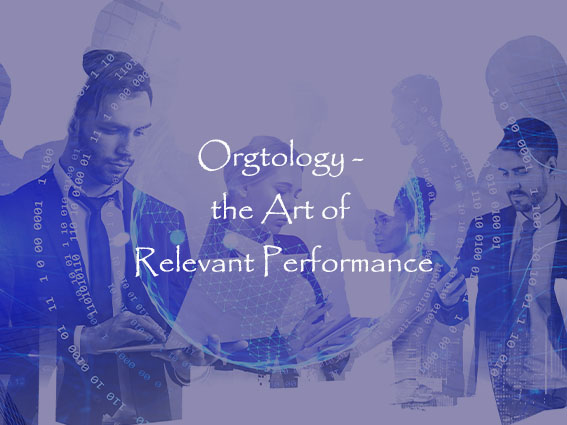
Join the Orgtologist Certification Program (OCP) - Empowering Executive Teams Worldwide
Copyright
© 2021-07-20: Derek hendrikz
When you subscribe to the blog, we will send you an e-mail when there are new updates on the site so you wouldn't miss them.


